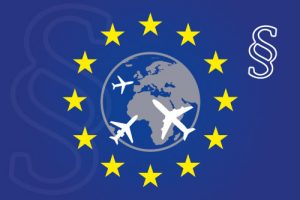Aircraft importation in the EU: does the flight pattern or geography and size or type of compensation matter?

This survey should be seen in connection with survey no. 1 about non-business use.
The survey was made before Brexit in 2020, which is why the UK, and the Isle of Man are included. The UK part is still relevant for aircraft flying to the UK under a UK full importation.
 Many corporate aircraft are flying internationally. We have therefore commissioned a verification survey about the impact when a fully EU-imported corporate aircraft is used for non-business purposes outside the EU. How can the compensation part be handled to prevent a correction of the input VAT if the VAT has already been deducted 100%?
Many corporate aircraft are flying internationally. We have therefore commissioned a verification survey about the impact when a fully EU-imported corporate aircraft is used for non-business purposes outside the EU. How can the compensation part be handled to prevent a correction of the input VAT if the VAT has already been deducted 100%?Figure 1: Corporate aircraft imported in various EU member states
Which geographic area will be included when the extent of non-business use of an imported corporate aircraft shall be determined concerning the correct VAT handling?
| Question | Denmark | Germany | UK | Isle of Man | Ireland | The Netherlands | Malta |
|---|---|---|---|---|---|---|---|
| Will the VAT authorities of the member state also include any flights flown worldwide? | Yes | n/a | Yes | Yes | Yes | Yes | Yes |
| The results are based on answers from international consulting firms in the respective countries. | |||||||
The result: geography matters
The geographic area is extremely relevant to look at in this context, and again, the result is almost unanimous. This means that any non-business legs flown, e.g., in the US by an American part 91 corporate operator, will impact the EU VAT handling if the aircraft has been fully imported into the EU and the VAT has been deducted 100%.
Figure 2: Corporate aircraft imported in various EU-member states
How is it possible for the management or owner family to pay compensation for any non-business use of a corporate aircraft?
| Questions | Denmark | Germany | UK | Isle of Man | Ireland | The Netherlands | Malta |
|---|---|---|---|---|---|---|---|
| Must the “private user” make a compensation payment to the importer at a “market-rate” level? | Yes | n/a | Yes | Yes | Yes | n/a | Yes |
| Can imputed income be used as a compensation payment? 1) | No | Yes | No | No | No | No | No |
|
The results are based on answers from international consulting firms in the respective countries. 1. Imputed income means that the importing entity is not receiving any direct compensation payment for non-business flights. |
|||||||
The result: size and type of compensation matters
The size of the compensation matters, and for most EU member states, an amount close to market rate must be paid as compensation to the importing entity for any non-business use of the aircraft. A correct compensation paid directly to the importing entity will typically mean that no correction of the input VAT is needed if the VAT has already been deducted 100%. The use of imputed income to compensate any private, personal, or entertainment use of a corporate aircraft is generally not accepted and will not exclude an EU VAT claim. Please also be aware that the US use of SIFL will not solve the compensation problem as these values are often too low to be considered market rate.
Important things to know about full importation
Operators should be aware that full importation includes a potential VAT and tax liability, requires onwards continuous correct worldwide economic activity as well as correct handling of any potential worldwide non-business use and or non-commercial use; requirements that the TA procedure does not have. The statute of limitations is five years for full importation, and the use of the aircraft must worldwide stay fully compliant with current EU regulations until the end of this period.
How can we help?
If you have questions about the above, please do not hesitate to contact us.
